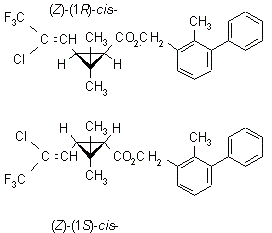Pesticides >> Insecticides >> Bifenthrin
Bifenthrin
Bifenthrin 92%TC
Bifenthrin 95%TC
Insecticide, acaricide
pyrethroid

NOMENCLATURE
Common name bifenthrin (BSI, ANSI, draft E-ISO); bifenthrine ((f)
draft F-ISO)
IUPAC name 2-methylbiphenyl-3-ylmethyl (Z)-(1RS,3RS)-3-(2-chloro-3,3,3-trifluoroprop-1-enyl)-2,2-dimethylcyclopropanecarboxylate
Roth: 2-methylbiphenyl-3-ylmethyl (Z)-(1RS)-cis-3-(2-chloro-3,3,3-trifluoroprop-1-enyl)-2,2-dimethylcyclopropanecarboxylate
Chemical Abstracts name (2-methyl[1,1'-biphenyl]-3-yl)methyl 3-(2-chloro-3,3,3-trifluoro-1-propenyl)-2,2-dimethylcyclopropanecarboxylate
CAS RN [82657-04-3]
Bifenthrin APPLICATIONS
Mode of action Contact and stomach action. Uses Effective against
a broad range of foliar pests, including Coleoptera, Diptera, Heteroptera,
Homoptera, Lepidoptera and Orthoptera; it also controls some species
of Acarina. Crops include cereals, citrus, cotton, fruit, grapes,
ornamentals and vegetables. Rates range from 5 g a.i./ha against
Aphididae in cereals to 45 g/ha against Aphididae and Lepidoptera
in top fruit. Formulation types EC; GR. SC; UL; WP. Compatibility
Not compatible with alkaline materials. Selected tradenames: 'Talstar'
(FMC)
Bifenthrin OTHER TRADENAMES
'Biflex' (FMC); 'Brigade' (FMC); 'Capture' (FMC); 'Semafor' (FMC);
'Starion' (FMC); 'Aripyreth' (for termites) (FMC, Nihon Nohyaku)
ANALYSIS
Product analysis by glc; hplc for analysis of isomer content. Residue
analysis by glc with ECD. Details available from FMC Agricultural
Chemicals Group. Analysis of pyrethroids reviewed by E. Papadopoulou-Mourkidou
in Comp. Analyt. Profiles.
MAMMALIAN TOXICOLOGY
Reviews FAO/WHO 65, 67 (see part 2 of the Bibliography). Oral Acute
oral LD50 for rats 54.5 mg/kg. Skin and eye Acute percutaneous LD50
for rabbits >2000 mg/kg. Non-irritant to skin; virtually non-irritating
to eyes (rabbits). No skin sensitisation (guinea pigs). NOEL (1
y) for dogs 1.5 mg/kg daily. Non-teratogenic in rats (£2 mg/kg
daily) and rabbits (8 mg/kg daily). ADI (JMPR) 0.02 mg/kg [1992].
Toxicity class WHO (a.i.) II; EPA (formulation) II
ECOTOXICOLOGY
Birds Acute oral LD50 for bobwhite quail 1800, mallard ducks 2150
mg/kg. Dietary LC50 (8 d) for bobwhite quail 4450, mallard ducks
1280 mg/kg diet. Fish LC50 (96 h) for bluegill sunfish 0.00035,
rainbow trout 0.00015 mg/l. Daphnia LC50 (48 h) 0.00016 mg/l. Low
solubility in water and high affinity for soil contribute to produce
little impact in aquatic systems under field conditions. Bees LD50
(oral) 0.1 mg/bee; (contact) 0.01462 mg/bee.